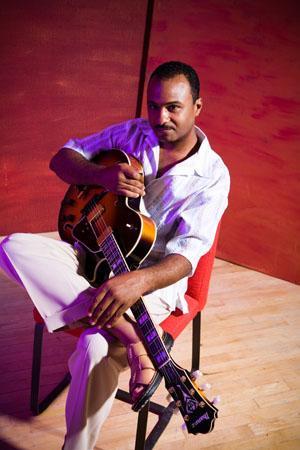
Interview by Joe Montague
 NuGroove
Records keeps adding excellent smooth jazz artists to their label and they
appear to have another future chartbuster in guitarist Dee Brown. His single,
“El Spanyo,” has suggestions of Norman Brown and his upbeat, brightly colored,
“Reunited,” contains hints of artists such as Nils. Both songs are from Brown’s
current CD,
No Time To Waste,
and “El Spanyo,” is quickly building an audience on the airwaves.
NuGroove
Records keeps adding excellent smooth jazz artists to their label and they
appear to have another future chartbuster in guitarist Dee Brown. His single,
“El Spanyo,” has suggestions of Norman Brown and his upbeat, brightly colored,
“Reunited,” contains hints of artists such as Nils. Both songs are from Brown’s
current CD,
No Time To Waste,
and “El Spanyo,” is quickly building an audience on the airwaves.
In support of the single, “El
Spanyo,” Dee Brown recently performed before a sold out venue in
Brown explains how, “El Spanyo,”
was given birth, “Gerald Mitchell (his producer) had some chords going on, and
he said, ‘
One of the reasons that I
brought Gerald into the project, is you will hear sounds that you never have
really heard in jazz music. For instance on the song, “
Unlike most songs which are inspired long before the artist is in the recording
studio, Brown’s title track, “No Time To Waste,” originated during the
production of this album.
Brown recalls, “The reason that I gave the
song this name is, it was typical of what was happening while we were recording.
My producer Gerald Mitchell does house and techno music, so at the time that we
were recording, he was traveling on a world tour in
While preparing to record the
album
No Time To Waste, Brown reflected upon the
musical tastes of smooth jazz listeners, “The smooth jazz listener is probably
from twenty-five years old and up, and that person usually listens to R&B music
from twenty years ago.
The way that I tried to make my music was so
that it appeared as though I was singing through my instrument. I was trying to
create a melody that could be sung by a singer, and then I would put the
background in, because it was a big part of the music twenty years ago with
groups such as The Commodores and Earth, Wind & Fire. I tried to put the CD
together for that listener. He or she doesn’t want to listen to today’s R&B,
which is more like hip-hop, because it is creating the wrong kind of texture,
words and meaning for him or her. These people (the listeners) are more into
love songs and romance.”
Brown has some more thoughts
on why people are attracted to the music on
No Time To
Waste, “I think the whole thing is,
instead of me saying I am this great musician, it is about the song. What can I
do with the songs to make them more pleasing to the listeners? That is the
approach that I took with
No Time To Waste,
before I added the vocals, sax and guitar to the songs. None of the music is
overbearing. It gives you the appearance that everything is working together and
that is how I wanted it to be.”
Several of the songs from
No Time To Waste
feature performances by awe-inspiring vocalists, one of whom is Audra Bryant,
who appears on, “Sunday Jazz.”
Bryant, who refers to herself as a soul / R&B,
neo-soul artist and who hails from
Producer Mitchell and Brown already had their melody for the song “Sunday Jazz,”
but were looking for something else to add to the tune.
Mitchell suggested that they needed a female
vocalist to sing on, “Sunday Jazz.”
While Mitchell was at the Submerge Records’
recording studio in
Brown says, “I was thinking that Audra would need time
to write the song, because all that we gave her was the title. The next day she
came back with all of the words and she did all of the vocals. She was
incredible.”
Bryant also contributes background vocals to the # 12
track, “Call Me Up.”
Outstanding vocal performances are also served up by
Reginald B. Williams Jr. and Asha Williams, on the song, “Before I Began.”
Brown is already working on his next, yet to be named
CD. “On this new project, I am trying to do a standard jazz song. I don’t know
how well it will be received, because people who like old jazz tend to buy the
people who originally did it. They don’t care who else did it, if Miles David
did it, they want Miles.”
For those who are already enjoying the funkier side of
Dee Brown’s music, never fear, because he is pretty excited about the song,
“Truth Seeker,” which is slotted as one of the tracks for the new album.
Referring to, “Truth Seeker,”
Brown says, “It is a song that I truly got a good vibe on. It was written by my
good friend and bass player Dave Henderson (who also appears on
No Time To
Waste) and it is produced by Gerald
Mitchell. “Truth Seeker,” has a funky, rock vibe that is infectious. When you
hear it, your head starts to bop, and your toe starts to tap and you are in that
groove.”
The song, “Truth Seeker,” will also feature some
high-octane performances as the saxophone and guitar court one another. Brown
says the song stimulates plenty of good feelings.
This fall NuGroove Records will be releasing a
compilation Christmas album and Dee Brown has contributed the traditional song,
“Hark The Herald Angels Sing.”